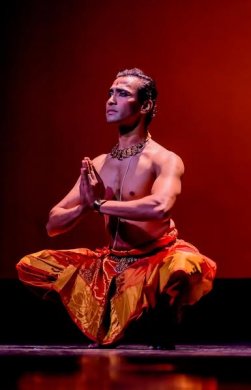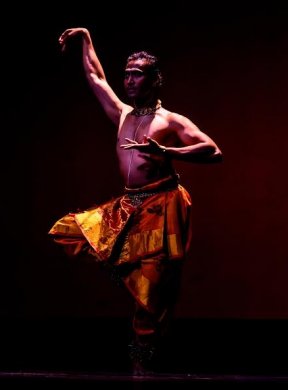
|   |

|   |
Manasaa by Ganesh Vasudeva - Priya Das e-mail: priyafeatures@gmail.com May 20, 2017  Ganesh Vasudeva, a rising independent star on the Bay Area Bharatanatyam
stage, presented 'Manasaa: a Man, a Manifest' on April 16th at the
Cubberley Auditorium in Palo Alto. The name and tagline offered a clue
into what the program was about, as was also indicated in the posts
leading up to the event; it was Ganesh's own manifest: an internalized
interpretation of the pieces as well as an assertion of and by a male
character. Ganesh Vasudeva, a rising independent star on the Bay Area Bharatanatyam
stage, presented 'Manasaa: a Man, a Manifest' on April 16th at the
Cubberley Auditorium in Palo Alto. The name and tagline offered a clue
into what the program was about, as was also indicated in the posts
leading up to the event; it was Ganesh's own manifest: an internalized
interpretation of the pieces as well as an assertion of and by a male
character.He lived up to this expectation, by explaining the why and how behind each presentation. He even "owned" the first, Pancha Nadai Alaripu, since the concept and patterned sollukattu were originals. Many dancers start slow and then pick up steam, others do the opposite; with Ganesh, one has come to expect consistent. He started strong with clean lines and cross-linkages between adavu patterns. He also made full use of the overhead space, a definite improvement from past performances. A mention must be made here of Ganesh's commitment to educating his audience in the beauty of Carnatic music and its bond with Bharatanatyam; he conducted a lec-dem a few months ago that illustrated this. He reinforced the bond in his choice of the second item, the Ragam Taanam Pallavi, a mainstay of a Carnatic music concert. He beautifully explored this concept on many levels: A musician explores his own manodharma (self-exploration of identity) in this piece, while at the same time exploring the raga to its full potential: following the notes to wherever they lead, coaxing our minds to soar with the melody. Ganesh did all of this too, albeit through dance. He explained that through his "Dance of Shiva at Chidambaram" (Khamas, khanda thriputa tala) he would elaborate and explore at mythological, philosophical, iconographical, rhythmic and personal levels. He etched the highlights of Shiva's form and what they meant to him personally: The damaru, as the relentless conflict in our life and the snake as a reminder to be constantly vigilant, were especially memorable here. Ganesh has an inherent minimalist style which rendered this to be an immersive experience. The next piece, Krishna's narrative woven through the Geeta Govinda was a revelation of a man's emotional turmoil. It was an enlightening experience to see a man astir with anxiety, remorse, and confusion. It was an "Oh!?" moment for the women in the audience, that a man can also go through a spectrum of suffering, especially since Ganesh's Krishna had not realized the impact his light-hearted flirtation would have on Radha. It was novel to see that Krishna is unable to both, dismiss Radha's reaction and get over the separation. It was stunning, the way he gets petulant with Kama: "I am Krishna, I am not your arch enemy Shiva. I wear garlands made of flowers around my neck, not snakes. This blue streak on my neck is just a string of wild flowers, not kalakuta poison. This is sandal wood paste on my body, not ashes. I am Krishna, not Shiva. Go away...go away..." The original composition by Snigdha Venkataramani was magical, it aided and abetted in the collective emotional ambush that the audience felt. Other highlights of this piece were: The initial jathi, which was in keeping with the mood of the piece; when Krishna realizes his mistake, one could picture him saying "Oh damn!"; when he wishes for Radha to say his name just one more time; when he is a picture of hope and despair as he makes a bed of flowers; the last section where Krishna and Radha literally fulfill each other, it was an ardhanari-esque move. The orchestra, comprising vocals by Snigdha, nattuvangam by Jayanthi Sridharan, mridangam by Rohan Krishnamurthy, flute by Ashwin Krishnakumar, and violin by Nayantara Narasimhan, was simply marvelous, in this piece and throughout. A significant distraction was the lighting, which was in general more in shadow, and one felt as though the subtleties of Ganesh's expressions were missed. His eye makeup could have been bolder, to make it easier for the audience to follow along. The next, an original composition highlighting the side effects of Krishna's "Stri chitta chora" behavior, made for a nice contrast to the previous item. Set to Surutti by Snigdha, with a humorous play on words (Aren't 16,000 wives enough for you, O Krishna? Why do you steal all these girls like you stole butter?) by Dr. Pappu Venugopala Rao, it was a well put together, contemporary, perhaps never before narrated side of Krishna Leela. Ganesh's ability to coax the traditional mould of Bharatanatyam into a light hearted mode is certainly commendable.  The importance of raga to act as the invisible but very present of stage
"set" was highlighted in Ganesh's rendition of the Chaura Panchasikha.
Snigdha, again, had set the music, to raga Charukesi. The brave yet
heart-rending notes of her voice and melody along with the brilliant
lighting by Surabhi Bharadwaj made this last march of love memorable
(Chaura Panchasikha are the 50 verses sung by a Brahmin teacher
sentenced to death by guillotine for the crime of falling in love with
the Princess). The interludes of soulful love delicately danced by
Ganesh and Surabhi made for a more exquisitely sad presentation. The
only fault that can be found in this piece was that Ganesh should not
have enacted the death; it was overly dramatic, especially since the
rest of the piece was compellingly sensitive. That Ganesh chose to
dedicate this padam to all those who sacrifice for love was poignant;
indeed, one of significant contributions artists make to society is to
ensure the longevity of human stories and heroes. The importance of raga to act as the invisible but very present of stage
"set" was highlighted in Ganesh's rendition of the Chaura Panchasikha.
Snigdha, again, had set the music, to raga Charukesi. The brave yet
heart-rending notes of her voice and melody along with the brilliant
lighting by Surabhi Bharadwaj made this last march of love memorable
(Chaura Panchasikha are the 50 verses sung by a Brahmin teacher
sentenced to death by guillotine for the crime of falling in love with
the Princess). The interludes of soulful love delicately danced by
Ganesh and Surabhi made for a more exquisitely sad presentation. The
only fault that can be found in this piece was that Ganesh should not
have enacted the death; it was overly dramatic, especially since the
rest of the piece was compellingly sensitive. That Ganesh chose to
dedicate this padam to all those who sacrifice for love was poignant;
indeed, one of significant contributions artists make to society is to
ensure the longevity of human stories and heroes. Ganesh made an excellent choice of Thillana, it was literally a joyous celebration, since he chose "Nachke aye natkat Giridhar" in Basanth raga, by Ambujam Krishna. Krishna is the life of Vrindavan and Vrindavan makes him feel alive. Ganesh's depictions of the various animals and birds were an example of detail and dexterity. Even though one has seen various dancers depict this before, this was perhaps a first for Ganesh, and well done. The one area of improvement would be in building more of a "presence" in pure nritta. A dancer must have a dancing personality that is their own, and it must be projected to the point that it sucks up the space between audience and dancer, when it feels as though it is a one-on-one experience.While it is true that dance is a humble offering, it is also an offering that is larger-than-life; this is what Ganesh must work towards. Attention must also be paid to depictions of Lord Shiva. As a male dancer portraying a male god, Ganesh must invest more into portraying magnificence, even as he is depicting bhakti. He must remember that bhakti is inspired by the sheer awe at Shiva's form. That awe-striking energy must be made real for the audience. Lastly, it is extremely heartening to see that Bharatanatyam dancers are using the medium to talk about lokadharma or even contemporary situations. One has come to expect that from Ganesh. Priya Das is a writer based in San Francisco Bay Area, USA, covering extraordinary nuances of everyday life with a focus on the performing arts. She is a regular contributor to India Currents. Some of her writing is at www.priyafeatures.com |